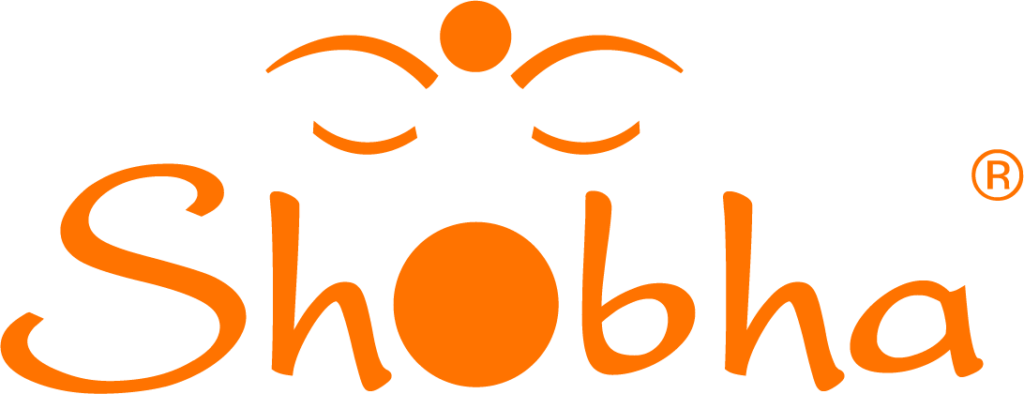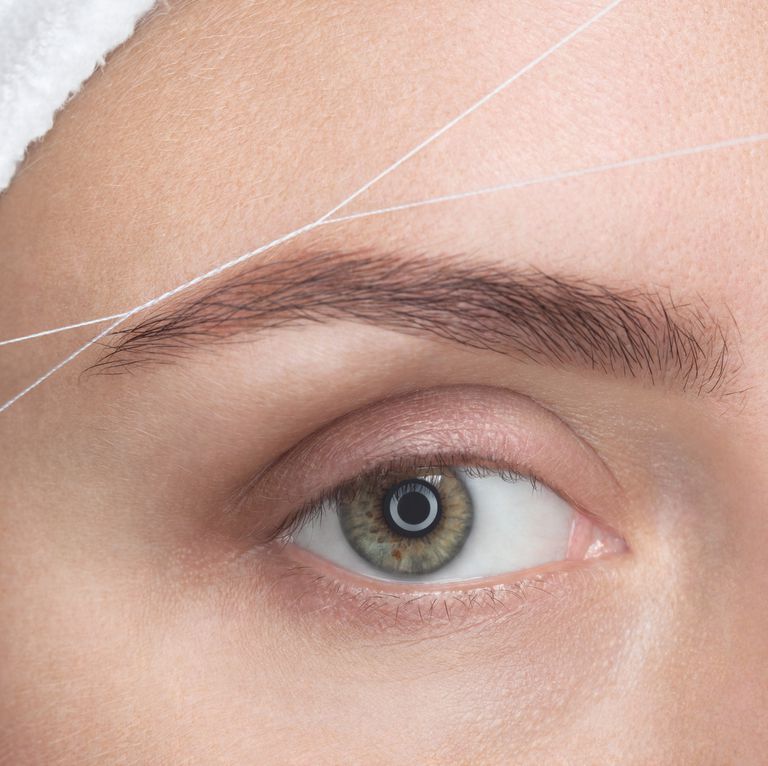Eyebrow trends come and go, but whether you prefer a neat and tidy arch or some vintage Brooke Shields boldness to your brows, almost all of us find ourselves in need of a little shaping and clean up on occasion. And while here are several classic go-tos when it comes to perfecting your arches—breaking out your tweezers or reaching for some wax—those aren’t the only options out there.
Threading, a centuries-old hair removal process stemming from south Asia and the Middle East, has been gaining popularity for years now. So what’s all the fuss about? We dug into all of your burning questions about brow threading so you can pick the right removal method for you.
HOW DOES EYEBROW THREADING WORK?
Threading is no misnomer. In fact, the hair removal tool in threading in nothing more than thread held between a technician’s hands (and in some cases, their teeth as well) in a twisted configuration. As the technician moves their hands, spaces open between those twists and then tighten again, grabbing and holding onto hair, and pulling it free, root and all. If you’ve ever used an epilator before, you’re familiar with the basic concept.
HOW IS IT DIFFERENT FROM WAXING OR TWEEZING?
There are a couple of reasons threading fans choose to forgo their tweezers and cancel their waxing appointments. The first comes down to precision.
“Threading is very precise and allows our specialists to have greater control over which hairs are removed,” says Shobha Tummala, founder of the hair removal hot-spot Shobha. So where waxes remove any swath of hair it comes into contact with, which can sometimes result in harsh lines, threading allows for a more natural look. Jaimineey Patel, head of training at Blink Brow Bar in London adds, “The cotton thread technique enables you to dictate the hairs that you want to keep or remove – meaning the perfect shape every time.”
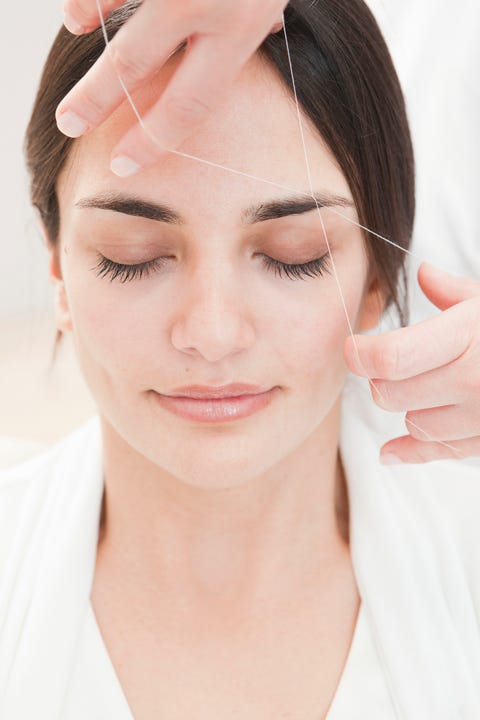
The hair factor is, of course, vital to hair removal, another area where threading stands out is its effects on the skin—or rather, the lack thereof.
Threading “doesn’t pull or nick the skin like waxing or tweezing can,” says Patel. You see, waxes typically involve heat as well as chemicals (natural or synthetic) that can cause some skin types to break out and the removal process can sometimes damage skin, leading to redness and peeling, especially for those using skin treatments like retinol. Not exactly what most of us hope for when we get our brows done.
While tweezing is generally less damaging for skin than waxing, accidentally poking, scraping, or pulling on skin with a pair of tweezers (especially an unsterilized pair that’s been sitting in your medicine cabinet) can lead to breaks in the skin and even infections. Since threading is performed with soft fibers at the surface level, it won’t accidentally grip the edge of a follicle or scratch skin.
In fact, Tummala is such a believer in the safety benefits of brow threading that she doubles down at her Shobha locations. “We believe so strongly in this method that it is the only hair removal option we offer for the delicate area around the eyes,” she says.
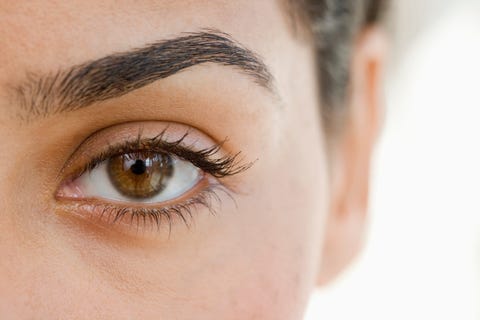
DOES BROW THREADING HURT?
The short answer: yes. While some argue that threading is less painful that tweezing or waxing since it’s fast and doesn’t involve tugging on the skin, the reality is that any form of hair removal that pulls the hair up from the root is going to involve some amount of pain. Sorry.
HOW MUCH DOES THREADING COST?
Obviously it depends on where you go and the state of your brows, but a typical 10-20 minute brow threading session can run anywhere from $15 to $45.
HOW LONG DO THREADING RESULTS LAST?
Everyone’s hair grows at a different rate, but on average, hair removal from threading can last between 2 and 5 weeks. You can also maintain the look for longer with touch-up appointments that are less intensive than a full-scale brow shaping.
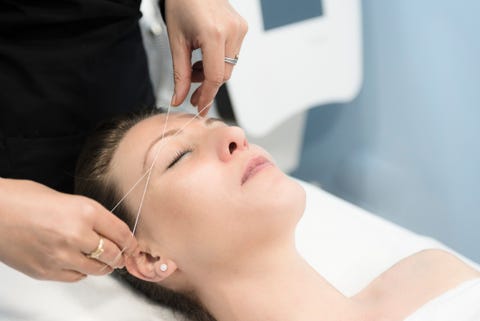
DOES THREADING WORK FOR ALL SKIN AND HAIR TYPES?
Essentially, yes. The lack of skin damage and chemicals makes threading appropriate for those on medications that can cause skin sensitivity, like retinoids and certain acne medications as well as those prone to breaking out after waxing. Likewise, threading is great at grabbing even the tiniest hairs (Tummala even suggests it for peach fuzz or short, stubbly hairs before a big event) so those with fine brows are set.
The exceptions? Anyone who’s experiencing heightening sensitivity (like after getting a chemical peel or microdermabrasion) and those who have recently had cosmetic surgery should sit threading out. “We recommend checking with your physician first, and then come back to us 3-4 weeks after the surgery for your threading appointment so your skin has had some time to heal,” says Tummala.
ARE THERE ANY SIDE EFFECTS FROM THREADING?
As with any form of hair removal, redness and breakouts are the biggest potential side effects from threading. Redness typically subsides within an hour or two of threading (so don’t schedule right before a party) but you can help calm things down with an anti-inflammatory cream like hydrocortisone or good old fashioned ice.
As for breakouts, it all comes down to taking good care of your newly-bared brows. “Post threading, your pores will be wide open to irritation so it is important to avoid touching the threaded area,” warns Patel. “For the next 24 hours we would also suggest avoiding swimming pools, saunas, steam rooms, hot temperatures and direct sunlight, if possible.” And for optimum results, maybe take a breather from your cosmetics routine. “Spray tans can clog the pores, as can certain makeup, so be careful if applying makeup on to the brows and try to avoid altogether if you’ve had other parts of the face threaded,” she says.
